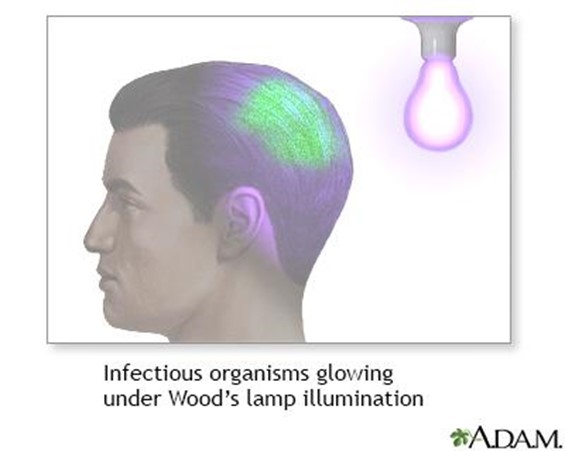The physician suspects a client has a dermatological infection. Which of the following diagnostics will be ordered to observe color changes to the skin using an ultraviolet light source?
Culture
KOH
Diascopy
Wood's
The Correct Answer is D
Choice A Reason: Culture is not a diagnostic test that uses an ultraviolet light source, but a laboratory test that involves growing microorganisms from a sample of body fluid or tissue. Culture can help identify the type and sensitivity of the infection-causing agent.
Choice B Reason: KOH is not a diagnostic test that uses an ultraviolet light source, but a chemical test that involves applying potassium hydroxide to a sample of skin, hair, or nail. KOH can help diagnose fungal infections by dissolving the keratin and revealing the fungal elements under a microscope.
Choice C Reason: Diascopy is not a diagnostic test that uses an ultraviolet light source, but a physical test that involves applying pressure to a lesion with a glass slide or lens. Diascopy can help differentiate between blanchable and non-blanchable lesions, such as erythema or petechiae.
Choice D Reason: Wood's is a diagnostic test that uses an ultraviolet light source, also known as a Wood's lamp or black light. Wood's can help observe color changes to the skin that are not visible under normal light, such as fluorescence or hypopigmentation. Wood's can help diagnose conditions such as tinea capitis, vitiligo, or erythrasma.

Nursing Test Bank
Naxlex Comprehensive Predictor Exams
Related Questions
Correct Answer is C
Explanation
Choice A Reason: This is incorrect because a blister-like pustule on the face that oozes clear fluid may indicate impetigo, which is a bacterial skin infection, not basal cell carcinoma. Basal cell carcinoma is a type of skin cancer that arises from the basal layer of the epidermis, which is the outermost layer of the skin. Basal cell carcinoma lesions are usually not blistered or pustular, but rather smooth, shiny, or waxy.
Choice B Reason: This is incorrect because a dark brown lesion that is flat may indicate a mole, which is a benign growth of melanocytes, which are cells that produce pigment, not basal cell carcinoma. Basal cell carcinoma lesions are usually not dark brown or flat, but rather flesh-colored, pink, or red, and may have a raised or indented center.
Choice C Reason: This is correct because a small scaly, dry lesion on the elbow may indicate basal cell carcinoma. Basal cell carcinoma lesions are often small, scaly, and dry, and may bleed or crust over. They can occur anywhere on the body, but are more common on areas that are exposed to the sun, such as the face, neck, arms, or legs.
Choice D Reason: This is incorrect because location on the top of the head where exposed frequently to sunlight may indicate squamous cell carcinoma, which is another type of skin cancer that arises from the squamous layer of the epidermis, not basal cell carcinoma. Squamous cell carcinoma lesions are usually rough, scaly, or crusted, and may have a firm or hard texture. They can also occur anywhere on the body, but are more common on areas that are exposed to the sun.
Correct Answer is D
Explanation
Choice A Reason: This is incorrect because turning off the lights and TV and closing the door may increase the client's anxiety and confusion. The nurse should provide adequate lighting and familiar objects to help orient the client.
Choice B Reason: This is incorrect because using restraints may increase the risk of injury, infection, and psychological distress for the client. The nurse should use restraints only as a last resort and with a physician's order.
Choice C Reason: This is incorrect because asking for a sedative may not address the underlying cause of the agitation. The nurse should use non-pharmacological interventions first, such as calming music, massage, or aromatherapy.
Choice D Reason: This is correct because identifying the cause of the agitation may help resolve it. The nurse should assess for possible triggers, such as pain, hunger, thirst, infection, or environmental factors.
Whether you are a student looking to ace your exams or a practicing nurse seeking to enhance your expertise , our nursing education contents will empower you with the confidence and competence to make a difference in the lives of patients and become a respected leader in the healthcare field.
Visit Naxlex, invest in your future and unlock endless possibilities with our unparalleled nursing education contents today
Report Wrong Answer on the Current Question
Do you disagree with the answer? If yes, what is your expected answer? Explain.
Kindly be descriptive with the issue you are facing.
